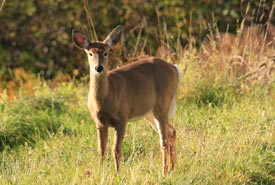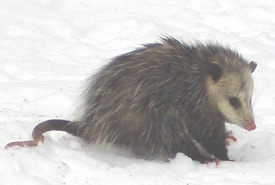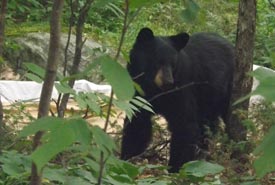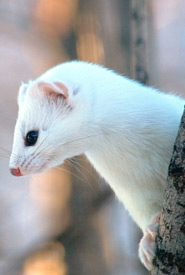Mammals of the Happy Valley Forest

White-tailed deer thrive in Happy Valley Forest wintering in the Hemlock areas of relatively less snow. (Photo by Dean Mullin)
In the wintertime the mammals are the most conspicuous form of life in the forest. The largest is the white-tailed deer, of which as many as nine have appeared below our feeder.
Squirrels are the commonest mammal, with the black and its colour variants being the very commonest. We have had as many as 16 around our feeder towards the end of the winter (they do not hibernate). They are occasionally scooped up by the ever vigilant goshawk or peregrine. The red squirrel is less common, much more active and will occasionally get into the house. On one occasion one was unwittingly locked in and, in attempting to get out, chewed the framework of a couple of big windows so that they had to be replaced. What a lesson!
The same habit of trying to get into the house is seen in the chipmunk — a hyper-active animal.

Virginia opossum an occasional visitor to the Happy Valley Forest in recent days. (Photo by Paul and Vicki Hotte)
Virginia opossums are being observed recently. Possibly more evidence of global warming.
Deer spend the winter in the forest but recognize the lack of deep snow under the umbrella in suitable areas of coniferous growth, especially hemlock, as a safe haven. By being alert they can survive aggressive coyotes who favour the lame or the young deer. The red fox is a permanent resident of the Happy Valley Forest, raising its pups in burrows. In the early spring the foxes are seen attacking mice in the meadows.
Coyotes are plentiful and have reduced the rabbit, groundhog and raccoon populations in some areas quite considerably. These coyotes are the commonest survivors among large mammals from early days in the Happy Valley Forest. They blend beautifully into the brown grass in fall and winter. They tend to hunt in flocks of five or six and even eight or nine, running together and hunting smaller mammals (domestic or otherwise). Their wild cry may be heard at any time of the day or night. At times it is quite close to the house, where they may seek out domestic cats. I will frequently be awakened from sleep by their wild cry. I love it! Larger animals — cattle, sheep and young deer — are taken when available.

Black bear (Photo by Paul and Vicki Hote)
On rare but increasing occasions a black bear is spotted in the forest. In the northern reaches of the Happy Valley Forest, Vicki and Paul Hotte have encountered wintering visits by black bears and apparently, recently, a couple of cubs. Whether they are breeding near the Holland River is not known, but it appears likely.
When we first went to this area, groundhogs were plentiful. Domestic dogs, as well as coyotes, reduced them by at least half.
Porcupines are scattered but common and leave a characteristic trail in the snow. So too does the long-tailed jumping mouse, where its long tail leaves its mark in the snow and it may be seen to have jumped more than a foot.
When all members of the family are visiting, some sleep in the cabin. Sometimes they have described horrible shrieking from beneath the cabin. We later learned that this was characteristic of mating porcupines. They are keen for the act they are committing but are careless of the potentially painful consequences.

Ermine (Photo contributed by friends of Dr. Henry Barnett)
The short-tailed weasel (or ermine) is occasionally seen in the summer in its chestnut brown phase of glistening fur. In wintertime it blends perfectly against the snow, but for the black ring around the tail that in snow betrays its presence by its movement. The ermine’s tracks in the snow are similar to those of a tiny squirrel. Frequently they are seen going for a couple of feet and then disappearing into a round hole in a snowbank. They will come up a foot or two later in the same snowbank. No other mammal has this habit, so they betray their identity and presence by this activity.
Muskrats, with their characteristic dwellings a foot or two above the surroundings in the reeds of the marshes or ponds, are scattered through the Happy Valley Forest. When they were more plentiful they were always in my own "big pond" and in the spring would venture as far as our garage, 300 feet away, looking for food (bird seed). I know of one or two places in the forest where there are still beavers with effective dams causing flooding and I know of one place where there is an otter family and slide.
I do not pretend to know the smallest mammals of the area; they turn up occasionally in the swimming pool. The only ones I recognize are the star-nosed mole and the common mole.
This is the 11th in a series of blog posts Dr. Barnett will be contributing to Land Lines in the next few months.


